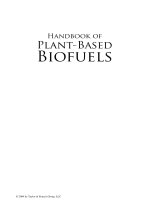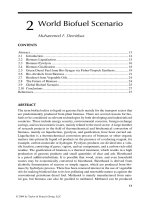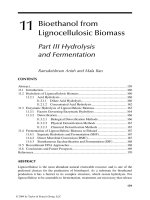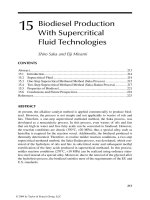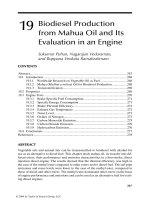Handbook of Spectroscopy potx
Bạn đang xem bản rút gọn của tài liệu. Xem và tải ngay bản đầy đủ của tài liệu tại đây (18.74 MB, 1,156 trang )
Handbook of Spectroscopy
Edited by G. Gauglitz and T. Vo-Dinh
Handbook of Spectroscopy
. Edited by Günter Gauglitz and Tuan Vo-Dinh
Copyright c 2003 WILEY-VCH Verlag GmbH & Co. KGaA, Weinheim
ISBN 3-527-29782-0
Related Titles from WILEY-VCH
H. Günzler and H U. Gremlich (eds)
IR Spectroscopy
2002. ca. 361 pages.
Hardcover. ISBN 3-527-28896-1
H. W. Siesler, Y. Ozaki, S. Kawata and H. M. Heise (eds)
Near-Infrared Spectroscopy
Principles, Instruments, Applications
2001. ca. 348 pages.
Hardcover. ISBN 3-527-30149-6
H. Günzler and A. Williams (eds)
Handbook of Analytical Techniques
2001. 2 Volumes, 1182 pages.
Hardcover. ISBN 3-527-30165-8
J. F. Haw (ed)
In-situ Spectroscopy in Heterogeneous Catalysis
2002. ca. 276 pages.
Hardcover. ISBN 3-527-30248-4
Handbook of Spectroscopy
. Edited by Günter Gauglitz and Tuan Vo-Dinh
Copyright c 2003 WILEY-VCH Verlag GmbH & Co. KGaA, Weinheim
ISBN 3-527-29782-0
Handbook of Spectroscopy
Edited by G. Gauglitz and T. Vo-Dinh
Handbook of Spectroscopy
. Edited by Günter Gauglitz and Tuan Vo-Dinh
Copyright c 2003 WILEY-VCH Verlag GmbH & Co. KGaA, Weinheim
ISBN 3-527-29782-0
Prof. Dr. Guenter Gauglitz
Institute for Physical and Theoretical
Chemistry
University of Tübingen
Auf der Morgenstelle 8
72976 Tübingen
Germany
Prof. Dr. Tuan Vo-Dinh
Advanced Biomedical Science
and Technology Group
Oak Ridge National Laboratory
P. O. Box 2008
Oak Ridge, Tennessee 37831-6101
USA
This book was carefully produced. Never-
theless, editors, authors and publisher do
not warrant the information contained
therein to be free of errors. Readers are
advised to keep in mind that statements,
data, illustrations, procedural details or
other items may inadvertently be inaccurate.
Library of Congress Card No.: applied for
A catalogue record for this book is available
from the British Library.
Bibliographic information published by
Die Deutsche Bibliothek
Die Deutsche Bibliothek lists this publication
in the Deutsche Nationalbibliografie;
detailed bibliographic data is available in the
Internet at
.
c 2003 WILEY-VCH Verlag GmbH & Co.
KGaA, Weinheim
All rights reserved (including those of
translation in other languages). No part of
this book m ay be reproduced in any form –
by photoprinting, microfilm, or any other
means – nor transmitted or translated into
machine language without written permis-
sion from the publishers. Registered names,
trademarks, etc. used in this book, even
when not specifically marked as such, are
not to be considered unprotected by law.
Printed in the Federal Republic of Germany.
Printed on acid-free paper.
Typesetting Hagedorn Kommunikation,
Viernheim
Printing Strauss Offsetdruck GmbH,
Mörlenbach
Bookbinding J. Schäffer GmbH & Co. KG,
Grünstadt
ISBN 3-527- 29782-0
Contents
Volume 1
Preface XXVIII
List of Contributors
Section I Sample Preparation and Sample Pretreatment 1
Introduction 3
1 Collection and Preparation of Gaseous Samples 4
1.1 Introduction 4
1.2 Sampling considerations 5
1.3 Active vs. Passive Sampling 8
1.3.1 Active Air Collection Methods 8
1.3.1.1 Sorbents 9
1.3.1.2 Bags 11
1.3.1.3 Canisters 11
1.3.1.4 Bubblers 12
1.3.1.5 Mist Chambers 13
1.3.1.6 Cryogenic Trapping 13
1.3.2 Passive Sampling 13
1.4 Extraction and Preparation of Samples 14
1.5 Summary 15
2 Sample Collection and Preparation of Liquid and Solids 17
2.1 Introduction 17
2.2 Collection of a Representative Sample 17
2.2.1 Statistics of Sampling 18
2.2.2 How Many Samples Should be Obtained? 21
2.2.3 Sampling 22
2.2.3.1 Liquids 22
2.2.3.2 Solids 23
2.3 Preparation of Samples for Analysis 24
VContents
Handbook of Spectroscopy
. Edited by Günter Gauglitz and Tuan Vo-Dinh
Copyright c 2003 WILEY-VCH Verlag GmbH & Co. KGaA, Weinheim
ISBN 3-527-29782-0
2.3.1 Solid Samples 24
2.3.1.1 Sample Preparation for Inorganic Analysis 25
2.3.1.2 Decomposition of Organics 28
2.3.2 Liquid Samples 29
2.3.2.1 Extraction/Separation and Preconcentration 29
2.3.2.2 Chromatographic Separation 31
Section II Methods 1: Optical Spectroscopy 37
3 Basics of Optical Spectroscopy 39
3.1 Absorption of Light 39
3.2 Infrared Spectroscopy 41
3.3 Raman Spectroscopy 43
3.4 UV/VIS Absorption and Luminescence 44
4 Instrumentation 48
4.1 MIR Spectrometers 48
4.1.1 Dispersive Spectrometers 49
4.1.2 Fourier-Transform Spectrometers 50
4.1.2.1 Detectors 53
4.1.2.2 Step-scan Operation 53
4.1.2.3 Combined Techniques 54
4.2 NIR Spectrometers 54
4.2.1 FT-NIR Spectrometers 55
4.2.2 Scanning-Grating Spectrometers 55
4.2.3 Diode Array Spectrometers 56
4.2.4 Filter Spectrometers 56
4.2.5 LED Spectrometers 56
4.2.6 AOTF Spectrometers 56
4.3 Raman Spectrometers 57
4.3.1 Raman Grating Spectrometer with Single Channel Detector 57
4.3.1.1 Detectors 59
4.3.1.2 Calibration 60
4.3.2 FT-Raman Spectrometers with Near-Infrared Excitation 61
4.3.3 Raman Grating Polychromator with Multichannel Detector 61
4.4 UV/VIS Spectrometers 63
4.4.1 Sources 64
4.4.2 Monochromators 64
4.4.3 Detectors 64
4.5 Fluorescence Spectrometers 66
5 Measurement Techniques 70
5.1 Transmission Measurements 71
5.2 Reflection Measurements 73
5.2.1 External Reflection 73
VI Contents
5.2.2 Reflection Absorption 75
5.2.3 Attenuated Total Reflection (ATR) 75
5.2.4 Reflection at Thin Films 77
5.2.5 Diffuse Reflection 78
5.3 Spectroscopy with Polarized Light 81
5.3.1 Optical Rotatory Dispersion 81
5.3.2 Circular Dichroism (CD) 82
5.4 Photoacoustic Measurements 83
5.5 Microscopic Measurements 84
5.5.1 Infrared Microscopes 85
5.5.2 Confocal Microscopes 85
5.5.3 Near-field Microscopes 86
6 Applications 89
6.1 Mid-Infrared (MIR) Spectroscopy 89
6.1.1 Sample Preparation and Measurement 89
6.1.1.1 Gases 90
6.1.1.2 Solutions and Neat Liquids 91
6.1.1.3 Pellets and Mulls 92
6.1.1.4 Neat Solid Samples 94
6.1.1.5 ReflectionÀAbsorption Sampling Technique 94
6.1.1.6 Sampling with the ATR Technique 95
6.1.1.7 Thin Samples 96
6.1.1.8 Diffuse Reflection Sampling Technique 97
6.1.1.9 Sampling by Photoacoustic Detection 97
6.1.1.10 Microsampling 98
6.1.2 Structural Analysis 98
6.1.2.1 The Region from 4000 to 1400 cm
À1
102
6.1.2.2 The Region 1400À900 cm
À1
102
6.1.2.3 The Region from 900 to 400 cm
À1
102
6.1.3 Special Applications 103
6.2 Near-Infrared Spectroscopy 104
6.2.1 Sample Preparation and Measurement 105
6.2.2 Applications of NIR Spectroscopy 110
6.3 Raman Spectroscopy 112
6.3.1 Sample Preparation and Measurements 112
6.3.1.1 Sample Illumination and Light Collection 113
6.3.1.2 Polarization Measurements 118
6.3.1.3 Enhanced Raman Scattering 119
6.3.2 Special Applications 120
6.4 UV/VIS Spectroscopy 125
6.4.1 Sample Preparation 125
6.4.2 Structural Analysis 129
6.4.3 Special Applications 132
6.5 Fluorescence Spectroscopy 135
VIIContents
6.5.1 Sample Preparation and Measurements 138
6.5.1.1 Fluorescence Quantum Yield and Lifetime 138
6.5.1.2 Fluorescence Quencher 139
6.5.1.3 Solvent Relaxation 144
6.5.1.4 Polarized Fluorescence 148
6.5.2 Special Applications 152
Section III Methods 2: Nuclear Magnetic Resonance Spectroscopy 169
Introduction 171
7 An Introduction to Solution, Solid-State, and Imaging
NMR Spectroscopy
177
7.1 Introduction 177
7.2 Solution-state
1
H NMR 179
7.3 Solid-state NMR 187
7.3.1 Dipolar Interaction 188
7.3.2 Chemical Shift Anisotropy 190
7.3.3 Quadrupolar Interaction 191
7.3.4 Magic Angle Spinning (MAS) NMR 194
7.3.5 T
1
and T
1r
Relaxation 195
7.3.6 Dynamics 198
7.4 Imaging 199
7.5 3D NMR: The HNCA Pulse Sequence 204
7.6 Conclusion 207
8 Solution NMR Spectroscopy 209
8.1 Introduction 209
8.2 1D (One-dimensional) NMR Methods 210
8.2.1 Proton Spin Decoupling Experiments 211
8.2.2 Proton Decoupled Difference Spectroscopy 212
8.2.3 Nuclear Overhauser Effect (NOE) Difference Spectroscopy 212
8.2.4 Selective Population Transfer (SPT) 213
8.2.5 J-Modulated Spin Echo Experiments 213
8.2.5.1 INEPT (Insensitive Nucleus Enhancement by Polarization
Transfer)
214
8.2.5.2 DEPT (Distortionless Enhancement Polarization Transfer) 215
8.2.6 Off-Resonance Decoupling 216
8.2.7 Relaxation Measurements 217
8.3 Two-dimensional NMR Experiments 218
8.3.1 2D J-Resolved NMR Experiments 219
8.3.2 Homonuclear 2D NMR Spectroscopy 223
8.3.2.1 COSY, Homonuclear Correlated Spectroscopy 223
8.3.2.2 Homonuclear TOCSY, Total Correlated Spectroscopy 226
8.3.2.3 NOESY, Nuclear Overhauser Enhancement Spectroscopy 228
VIII Contents
8.3.2.4 ROESY, Rotating Frame Overhauser Enhanced Spectroscopy 230
8.3.2.5 NOESY vs. ROESY 231
8.3.2.6 Other Homonuclear Autocorrelation Experiments 231
8.3.3 Gradient Homonuclear 2D NMR Experiments 232
8.3.4 Heteronuclear Shift Correlation 234
8.3.5 Direct Heteronuclear Chemical Shift Correlation Methods 234
8.3.5.1 HMQC, Heteronuclear Multiple Quantum Coherence 234
8.3.6 HSQC, Heteronuclear Single Quantum Coherence Chemical Shift
Correlation Techniques
236
8.3.6.1 Multiplicity-edited Heteronuclear Shift Correlation Experiments 237
8.3.6.2 Accordion-optimized Direct Heteronuclear Shift Correlation
Experiments
239
8.3.7 Long-range Heteronuclear Chemical Shift Correlation 240
8.3.7.1 HMBC, Heteronuclear Multiple Bond Correlation 242
8.3.7.2 Variants of the Basic HMBC Experiment 243
8.3.7.3 Accordion-optimized Long-range Heteronuclear Shift Correlation
Methods.
244
8.3.7.4
2
J
3
J-HMBC 248
8.3.7.5 Relative Sensitivity of Long-range Heteronuclear Shift Correlation
Experiments
251
8.3.7.6 Applications of Accordion-optimized Long-range Heteronuclear
Shift Correlation Experiments
252
8.3.8 Hyphenated-2D NMR Experiments 252
8.3.9 One-dimensional Analogues of 2D NMR Experiments 255
8.3.10 Gradient 1D NOESY 255
8.3.11 Selective 1D Long-range Heteronuclear Shift Correlation
Experiments
257
8.3.12 Small Sample NMR Studies 257
8.4 Conclusions 262
9 Solid-State NMR 269
9.1 Introduction 269
9.2 Solid-state NMR Lineshapes 272
9.2.1 The Orientational Dependence of the NMR Resonance Frequency 272
9.2.2 Single-crystal NMR 273
9.2.3 Powder Spectra 275
9.2.4 One-dimensional
2
H NMR 278
9.3 Magic-angle Spinning 280
9.3.1 CP MAS NMR 281
9.3.2
1
H Solid-State NMR 285
9.4 Recoupling Methods 287
9.4.1 Heteronuclear Dipolar-coupled Spins: REDOR 287
9.4.2 Homonuclear Dipolar-coupled Spins 290
9.4.3 The CSA: CODEX 291
9.5 Homonuclear Two-dimensional Experiments 292
IXContents
9.5.1 Establishing the Backbone Connectivity in an Organic Molecule 293
9.5.2 Dipolar-mediated Double-quantum Spectroscopy 295
9.5.3 High-resolution
1
H Solid-state NMR 298
9.5.4 Anisotropic – Isotropic Correlation: The Measurement of CSAs 300
9.5.5 The Investigation of Slow Dynamics: 2D Exchange 303
9.5.6
1
HÀ
1
H DQ MAS Spinning-sideband Patterns 305
9.6 Heteronuclear Two-dimensional Experiments 307
9.6.1 Heteronuclear Correlation 307
9.6.2 The Quantitative Determination of Heteronuclear Dipolar
Couplings
310
9.6.3 Torsional Angles 312
9.6.4 Oriented Samples 313
9.7 Half-integer Quadrupole Nuclei 315
9.8 Summary 319
Section IV Methods 3: Mass Spe ctrometry 327
10 Mass Spectrometry 329
10.1 Introduction: Principles of Mass Spectrometry 329
10.1.1 Application of Mass Spectrometry to Biopolymer Analysis 330
10.2 Techniques and Instrumentation of Mass Spectrometry 331
10.2.1 Sample Introduction and Ionisation Methods 331
10.2.1.1 Pre-conditions 331
10.2.1.2 Gas Phase (“Hard”) Ionisation Methods 331
10.2.1.3 “Soft” Ionisation Techniques 332
10.2.2 Mass Spectrometric Analysers 335
10.2.2.1 Magnetic Sector Mass Analysers 335
10.2.2.2 Quadrupole Mass Analysers 337
10.2.2.3 Time-of-Flight Mass Analysers 338
10.2.2.4 Trapped-Ion Mass Analysers 339
10.2.2.5 Hybrid Instruments 340
10.2.3 Ion Detection and Spectra Acquisition 340
10.2.4 High Resolution Fourier Transform Ion Cyclotron Resonance (ICR)
Mass Spectrometry
341
10.2.5 Sample Preparation and Handling in Bioanalytical Applications 344
10.2.5.1 LiquidÀLiquid Extraction (LLE) 344
10.2.5.2 Solid Phase Extraction (SPE) 345
10.2.5.3 Immunoaffinity Extraction (IAE) 345
10.2.5.4 Solid-phase Microextraction 345
10.2.5.5 Supercritical-Fluid Extraction (SFE) 346
10.2.6 Coupling of Mass Spectrometry with Microseparation Methods 346
10.2.6.1 Liquid Chromatography-Mass Spectrometry Coupling (LC-MS) 347
10.2.6.2 Capillary Electrophoresis (CE)-Mass Spectrometry 348
10.3 Applications of Mass Spectrometry to Biopolymer Analysis 349
X Contents
10.3.1 Introduction 349
10.3.2 Analysis of Peptide and Protein Primary Structures
and Post-Translational Structure Modifications
349
10.3.3 Tertiary Structure Characterisation by Chemical Modification
and Mass Spectrometry
353
10.3.4 Characterisation of Non-Covalent Supramolecular Complexes 354
10.3.5 Mass Spectrometric Proteome Analysis 356
Section V Methods 4: Elemental Analysis 363
11 X-ray Fluorescence Analysis 365
11.1 Introduction 365
11.2 Basic Principles 367
11.2.1 X-ray Wavelength and Energy Scales 367
11.2.2 Interaction of X-rays with Matter 367
11.2.3 Photoelectric Effect 369
11.2.4 Scattering 371
11.2.5 Bremsstrahlung 372
11.2.6 Selection Rules, Characteristic Lines and X-ray Spectra 373
11.2.7 Figures-of-merit for XRF Spectrometers 376
11.2.7.1 Analytical Sensitivity 376
11.2.7.2 Detection and Determination Limits 377
11.3 Instrumentation 380
11.3.1 X-ray Sources 380
11.3.2 X-ray Detectors 384
11.3.3 Wavelength-dispersive XRF 390
11.3.4 Energy-dispersive XRF 393
11.3.5 Radioisotope XRF 397
11.3.6 Total Reflection XRF 398
11.3.7 Microscopic XRF 399
11.4 Matrix Effects 401
11.4.1 Thin and Thick Samples 401
11.4.2 Primary and Secondary Absorption, Direct and Third Element
Enhancement
403
11.5 Data Treatment 404
11.5.1 Counting Statistics 404
11.5.2 Spectrum Evaluation Techniques 405
11.5.2.1 Data Extraction in WDXRF 406
11.5.2.2 Data Extraction in EDXRF: Simple Case, No Peak Overlap 407
11.5.2.3 Data Extraction in EDXRF, Multiple Peak Overlap 408
11.5.3 Quantitative Calibration Procedures 409
11.5.3.1 Single-element Techniques 412
11.5.3.2 Multiple-element Techniques 413
11.5.4 Error Sources in X-ray Fluorescence Analysis 415
XIContents
11.5.5 Specimen Preparation for X-ray Fluorescence 416
11.6 Advantages and Limitations 417
11.6.1 Qualitative Analysis 417
11.6.2 Detection Limits 418
11.6.3 Quantitative Reliability 418
11.7 Summary 419
12 Atomic Absorption Spectrometry (AAS) and Atomic Emission
Spectrometry (AES)
421
12.1 Introduction 421
12.2 Theory of Atomic Spectroscopy 421
12.2.1 Basic Principles 421
12.2.2 Fundamentals of Absorption and Emission 426
12.2.2.1 Absorption 429
12.2.2.2 Line Broadening 430
12.2.2.3 Self-absorption 431
12.2.2.4 Ionisation 432
12.2.2.5 Dissociation 434
12.2.2.6 Radiation Sources and Atom Reservoirs 434
12.3 Atomic Absorption Spectrometry (AAS) 436
12.3.1 Introduction 436
12.3.2 Instrumentation 436
12.3.2.1 Radiation Sources 437
12.3.2.2 Atomisers 440
12.3.2.3 Optical Set-up and Components of Atomic Absorption
Instruments
453
12.3.3 Spectral Interference 454
12.3.3.1 Origin of Spectral Interference 454
12.3.3.2 Methods for Correcting for Spectral Interference 455
12.3.4 Chemical Interferences 462
12.3.4.1 The Formation of Compounds of Low Volatility 463
12.3.4.2 Influence on Dissociation Equilibria 463
12.3.4.3 Ionisation in Flames 464
12.3.5 Data Treatment 465
12.3.5.1 Quantitative Analysis 465
12.3.6 Hyphenated Techniques 466
12.3.6.1 Gas Chromatography-Atomic Absorption Spectrometry 467
12.3.6.2 Liquid Chromatography-Atomic Absorption Spectrometry 469
12.3.7 Conclusion and Future Directions 470
12.4 Atomic Emission Spectrometry (AES) 471
12.4.1 Introduction 471
12.4.2 Instrumentation 471
12.4.2.1 Atomisation Devices 471
12.4.2.2 Optical Set-up and Detection 480
12.4.2.3 Instrumentation for Solid Sample Introduction 483
XII Contents
12.4.3 Matrix Effects and Interference 486
12.4.3.1 Spectral Interferences 486
12.4.3.2 Matrix Effects and Chemical Interferences 487
12.4.4 Quantitative and Qualitative Analysis 488
12.4.5 Advantages and Limitations 491
12.4.5.1 Absolute and Relative Sensitivity 491
12.4.5.2 Hyphenated Techniques 491
12.5 Summary 493
Section VI Methods 5: Surface Analysis Techniques 497
13 Surface Analysis Techniques 499
13.1 Introduction 499
13.2 Definition of the Surface 501
13.3 Selection of Method 501
13.4 Individual Techniques 506
13.4.1 Angle Resolved Ultraviolet Photoelectron Spectroscopy 506
13.4.1.1 Introduction 507
13.4.1.2 Instrumentation 507
13.4.1.3 Sample 507
13.4.1.4 Analytical Information 507
13.4.1.5 Performance Criteria 507
13.4.1.6 Applications 508
13.4.1.7 Other Techniques 508
13.4.2 Appearance Potential Spectroscopy 508
13.4.2.1 Introduction 508
13.4.2.2 Instrumentation 508
13.4.2.3 Sample 509
13.4.2.4 Analytical Information 509
13.4.2.5 Performance Criteria 509
13.4.2.6 Applications 509
13.4.2.7 Other Techniques 510
13.4.3 Atom Probe Field Ion Microscopy 510
13.4.3.1 Introduction 510
13.4.3.2 Instrumentation 510
13.4.3.3 Analytical Information 510
13.4.3.4 Performance Criteria 510
13.4.3.5 Applications 510
13.4.4 Attenuated Total Reflection Spectroscopy 511
13.4.4.1 Introduction 511
13.4.4.2 Instrumentation 511
13.4.4.3 Analytical Information 511
13.4.4.4 Performance Criteria 511
13.4.4.5 Applications 512
XIIIContents
13.4.5 Auger Electron Spectroscopy 512
13.4.5.1 Introduction 512
13.4.5.2 Instrumentation 512
13.4.5.3 Sample 513
13.4.5.4 Analytical Information 513
13.4.5.5 Performance Criteria 513
13.4.5.6 Applications 514
13.4.5.7 Other Techniques 514
13.4.6 Auger Photoelectron Coincidence Spectroscopy 514
13.4.6.1 Introduction 514
13.4.6.2 Instrumentation 515
13.4.6.3 Sample 515
13.4.6.4 Analytical Information 515
13.4.6.5 Performance Criteria 515
13.4.6.6 Applications 516
13.4.6.7 Other Techniques 516
13.4.7 Charge Particle Activation Analysis 516
13.4.7.1 Introduction 516
13.4.7.2 Instrumentation 516
13.4.7.3 Sample 517
13.4.7.4 Analytical Information 517
13.4.7.5 Performance Criteria 517
13.4.7.6 Application 518
13.4.7.7 Other Technique 518
13.4.8 Diffuse Reflection Spectroscopy 518
13.4.8.1 Introduction 518
13.4.8.2 Instrumentation 518
13.4.8.3 Analytical Information 519
13.4.8.4 Performance Criteria 519
13.4.8.5 Applications 519
13.4.9 Elastic Recoil Detection Analysis 520
13.4.9.1 Introduction 520
13.4.9.2 Instrumentation 520
13.4.9.3 Sample 520
13.4.9.4 Analytical Information 520
13.4.9.5 Performance Criteria 521
13.4.9.6 Applications 522
13.4.9.7 Other Techniques 522
13.4.10 Electron Momentum Spectroscopy 522
13.4.10.1 Introduction 523
13.4.10.2 Instrumentation 523
13.4.10.3 Sample 523
13.4.10.4 Analytical Information 523
13.4.10.5 Performance Criteria 523
13.4.10.6 Applications 523
XIV Contents
13.4.11 Electron Probe Microanalysis 524
13.4.11.1 Introduction 524
13.4.11.2 Instrumentation 524
13.4.11.3 Sample 524
13.4.11.4 Analytical Information 524
13.4.11.5 Performance Criteria 525
13.4.11.6 Applications 525
13.4.12 Electron Stimulated Desorption 525
13.4.12.1 Introduction 525
13.4.12.2 Instrumentation 525
13.4.12.3 Sample 526
13.4.12.4 Analytical Information 526
13.4.12.5 Performance Criteria 526
13.4.12.6 Applications 526
13.4.13 Electron Stimulated Desorption Ion Angular Distributions 526
13.4.13.1 Introduction 526
13.4.13.2 Instrumentation 527
13.4.13.3 Sample 527
13.4.13.4 Analytical Information 527
13.4.13.5 Performance Criteria 527
13.4.13.6 Applications 527
13.4.14 Ellipsometry 528
13.4.14.1 Introduction 528
13.4.14.2 Instrumentation 528
13.4.14.3 Sample 528
13.4.14.4 Analytical Information 528
13.4.14.5 Performance Criteria 529
13.4.14.6 Applications 529
13.4.15 Extended Energy Loss Fine Structure 529
13.4.15.1 Introduction 529
13.4.15.2 Instrumentation 530
13.4.15.3 Analytical Information 530
13.4.15.4 Performance Criteria 530
13.4.15.5 Applications 530
13.4.15.6 Other Techniques 530
13.4.16 Evanescent Wave Cavity Ring-down Spectroscopy 530
13.4.16.1 Introduction 531
13.4.16.2 Instrumentation 531
13.4.16.3 Performance Criteria 531
13.4.16.4 Applications 531
13.4.17 Glow Discharge Optical Emission Spectrometry 531
13.4.17.1 Introduction 531
13.4.17.2 Instrumentation 532
13.4.17.3 Sample 532
13.4.17.4 Analytical Information 532
XVContents
13.4.17.5 Performance Criteria 532
13.4.17.6 Application 533
13.4.17.7 Other Techniques 533
13.4.18 High Resolution Electron Energy Loss Spectroscopy 533
13.4.18.1 Introduction 533
13.4.18.2 Instrumentation 533
13.4.18.3 Sample 534
13.4.18.4 Analytical Information 534
13.4.18.5 Performance Criteria 534
13.4.18.6 Applications 535
13.4.18.7 Other Techniques 535
13.4.19 Inelastic Electron Tunneling Spectroscopy 535
13.4.19.1 Introduction 535
13.4.19.2 Instrumentation 536
13.4.19.3 Sample 536
13.4.19.4 Analytical Information 536
13.4.19.5 Performance Criteria 536
13.4.19.6 Applications 536
13.4.20 Inverse Photoelectron Spectroscopy 536
13.4.20.1 Introduction 536
13.4.20.2 Instrumentation 537
13.4.20.3 Sample 537
13.4.20.4 Analytical Information 537
13.4.20.5 Performance Criteria 538
13.4.20.6 Applications 538
13.4.21 Ion Neutralization Spectroscopy 538
13.4.21.1 Introduction 538
13.4.21.2 Instrumentation 538
13.4.21.3 Sample 539
13.4.21.4 Analytical Information 539
13.4.21.5 Performance Criteria 539
13.4.21.6 Applications 539
13.4.21.7 Other Techniques 539
13.4.22 Ion Probe Microanalysis 539
13.4.22.1 Introduction 540
13.4.22.2 Instrumentation 540
13.4.22.3 Sample 540
13.4.22.4 Analytical Information 540
13.4.22.5 Performance Criteria 541
13.4.22.6 Application 541
13.4.22.7 Other Techniques 541
13.4.23 Low-energy Ion Scattering Spectrometry 542
13.4.23.1 Introduction 542
13.4.23.2 Instrumentation 542
13.4.23.3 Sample 542
XVI Contents
13.4.23.4 Analytical Information 542
13.4.23.5 Performance Criteria 543
13.4.23.6 Application 543
13.4.23.7 Other Technique 543
13.4.24 Near Edge X-ray Absorption Spectroscopy 544
13.4.24.1 Introduction 544
13.4.24.2 Instrumentation 544
13.4.24.3 Sample 544
13.4.24.4 Analytical Information 544
13.4.24.5 Performance Criteria 544
13.4.24.6 Applications 545
13.4.24.7 Other Techniques 545
13.4.25 Neutron Depth Profiling 545
13.4.25.1 Introduction 545
13.4.25.2 Instrumentation 545
13.4.25.3 Sample 545
13.4.25.4 Analytical Information 545
13.4.25.5 Performance Criteria 546
13.4.25.6 Application 546
13.4.26 Particle Induced Gamma Ray Emission 546
13.4.26.1 Introduction 547
13.4.26.2 Instrumentation 547
13.4.26.3 Sample 547
13.4.26.4 Analytical Information 547
13.4.26.5 Performance Criteria 547
13.4.26.6 Applications 548
13.4.27 Particle Induced X-ray Emission 548
13.4.27.1 Introduction 548
13.4.27.2 Instrumentation 548
13.4.27.3 Sample 549
13.4.27.4 Spectrum 549
13.4.27.5 Analytical Information 549
13.4.27.6 Performance Criteria 550
13.4.27.7 Application 550
13.4.27.8 Other Techniques 550
13.4.28 Penning Ionisation Electron Spectroscopy 551
13.4.28.1 Introduction 551
13.4.28.2 Instrumentation 551
13.4.28.3 Sample 551
13.4.28.4 Analytical Information 551
13.4.28.5 Performance Criteria 552
13.4.28.6 Applications 552
13.4.28.7 Other Techniques 552
13.4.29 Photoacoustic Spectroscopy 552
13.4.29.1 Introduction 552
XVIIContents
13.4.29.2 Instrumentation 553
13.4.29.3 Analytical Information 553
13.4.29.4 Performance Criteria 553
13.4.29.5 Application 553
13.4.30 Photoemission Electron Microscopy 553
13.4.30.1 Introduction 554
13.4.30.2 Instrumentation 554
13.4.30.3 Sample 554
13.4.30.4 Analytical Information 554
13.4.30.5 Performance Criteria 554
13.4.30.6 Applications 555
13.4.31 Positron Annihilation Auger Electron Spectroscopy 555
13.4.31.1 Introduction 555
13.4.31.2 Instrumentation 555
13.4.31.3 Sample 556
13.4.31.4 Analytical Information 556
13.4.31.5 Performance Criteria 556
13.4.31.6 Applications 557
13.4.31.7 Other Techniques 557
13.4.32 Raman Spectroscopy 557
13.4.32.1 Introduction 557
13.4.32.2 Instrumentation 557
13.4.32.3 Sample 557
13.4.32.4 Analytical Information 558
13.4.32.5 Performance Criteria 558
13.4.32.6 Application 558
13.4.33 Reflection-absorption Spectroscopy 559
13.4.33.1 Introduction 559
13.4.33.2 Instrumentation 559
13.4.33.3 Sample 559
13.4.33.4 Analytical Information 560
13.4.33.5 Performance Criteria 560
13.4.33.6 Limitations 560
13.4.33.7 Applications 560
13.4.33.8 Other techniques 561
13.4.34 Reflection Electron Energy Loss Spectroscopy 561
13.4.34.1 Introduction 561
13.4.34.2 Instrumentation 561
13.4.34.3 Sample 561
13.4.34.4 Analytical Information 562
13.4.34.5 Performance Criteria 562
13.4.34.6 Applications 562
13.4.34.7 Other Techniques 562
13.4.35 Resonant Nuclear Reaction Analysis 563
13.4.35.1 Introduction 563
XVIII Contents
13.4.35.2 Instrumentation 563
13.4.35.3 Sample 564
13.4.35.4 Analytical Information 564
13.4.35.5 Performance Criteria 564
13.4.35.6 Application 564
13.4.35.7 Other Techniques 565
13.4.36 Rutherford Backscattering Spectrometry 565
13.4.36.1 Introduction 565
13.4.36.2 Instrumentation 565
13.4.36.3 Sample 565
13.4.36.4 Analytical Information 565
13.4.36.5 Performance Criteria 566
13.4.36.6 Applications 567
13.4.36.7 Other Techniques 567
13.4.37 Scanning Electron Microscopy 567
13.4.37.1 Introduction 568
13.4.37.2 Instrumentation 568
13.4.37.3 Sample 569
13.4.37.4 Analytical Information 569
13.4.37.5 Performance Criteria 569
13.4.37.6 Applications 570
13.4.38 Scanning Tunneling Spectroscopy 570
13.4.38.1 Introduction 570
13.4.38.2 Instrumentation 570
13.4.38.3 Sample 571
13.4.38.4 Analytical Information 571
13.4.38.5 Performance Criteria 571
13.4.38.6 Applications 571
13.4.38.7 Other Techniques 571
13.4.39 Secondary Ion Mass Spectrometry 571
13.4.39.1 Introduction 571
13.4.39.2 Instrumentation 572
13.4.39.3 Sample 572
13.4.39.4 Analytical Information 572
13.4.39.5 Performance Criteria 573
13.4.39.6 Application 573
13.4.39.7 Other Techniques 573
13.4.40 Spectroscopy of Surface Electromagnetic Waves 574
13.4.40.1 Introduction 574
13.4.40.2 Instrumentation 574
13.4.40.3 Performance Criteria 574
13.4.40.4 Applications 574
13.4.41 Spin Polarized Electron Energy Loss Spectroscopy 575
13.4.41.1 Introduction 575
13.4.41.2 Instrumentation 575
XIXContents
13.4.41.3 Sample 575
13.4.41.4 Analytical Information 575
13.4.41.5 Performance Criteria 575
13.4.41.6 Applications 576
13.4.41.7 Other Techniques 576
13.4.42 Spin Polarized Ultraviolet Photoelectron Spectroscopy 576
13.4.42.1 Introduction 576
13.4.42.2 Instrumentation 576
13.4.42.3 Sample 577
13.4.42.4 Analytical Information 577
13.4.42.5 Performance Criteria 577
13.4.42.6 Applications 577
13.4.43 Sum-Frequency Generation Vibrational Spectroscopy 578
13.4.43.1 Introduction 578
13.4.43.2 Instrumentation 578
13.4.43.3 Analytical Information 578
13.4.43.4 Performance Criteria 578
13.4.43.5 Applications 579
13.4.43.6 Other Methods 579
13.4.44 Surface Plasmon Resonance Spectroscopy 579
13.4.44.1 Introduction 579
13.4.44.2 Instrumentation 579
13.4.44.3 Analytical Information 579
13.4.44.4 Performance Criteria 580
13.4.44.5 Applications 580
13.4.45 Total Reflection X-ray Fluorescence Spectroscopy 580
13.4.45.1 Introduction 580
13.4.45.2 Instrumentation 580
13.4.45.3 Sample 581
13.4.45.4 Analytical Information 581
13.4.45.5 Performance Criteria 581
13.4.45.6 Applications 582
13.4.46 Transmission Spectroscopy 582
13.4.46.1 Introduction 582
13.4.46.2 Instrumentation 582
13.4.46.3 Performance Criteria 582
13.4.46.4 Applications 582
13.4.47 Ultraviolet Photoelectron Spectroscopy 583
13.4.47.1 Introduction 583
13.4.47.2 Instrumentation 583
13.4.47.3 Sample 583
13.4.47.4 Analytical Information 583
13.4.47.5 Performance Criteria 583
13.4.47.6 Applications 584
13.4.47.7 Other Techniques 584
XX Contents
13.4.48 X-ray Absorption Fine Structure 584
13.4.48.1 Introduction 584
13.4.48.2 Instrumentation 585
13.4.48.3 Analytical Information 585
13.4.48.4 Performance Criteria 585
13.4.48.5 Applications 585
13.4.48.6 Other Techniques 586
13.4.49 X-ray Photoelectron Diffraction 586
13.4.49.1 Introduction 586
13.4.49.2 Instrumentation 586
13.4.49.3 Sample 587
13.4.49.4 Analytical Information 587
13.4.49.5 Performance Criteria 587
13.4.49.6 Applications 587
13.4.50 X-ray Photoelectron Spectroscopy 587
13.4.50.1 Introduction 588
13.4.50.2 Instrumentation 588
13.4.50.3 Sample 589
13.4.50.4 Analytical Information 589
13.4.50.5 Performance Criteria 590
13.4.50.6 Applications 590
13.4.50.7 Other Techniques 591
13.4.51 X-ray Standing Wave 591
13.4.51.1 Introduction 591
13.4.51.2 Instrumentation 591
13.4.51.3 Sample 592
13.4.51.4 Analytical Information 592
13.4.51.5 Performance Criteria 592
13.4.51.6 Applications 593
13.5 Further Information 593
13.6 Appendix: List of Acronyms Related to Surface Analysis 594
XXIContents
Volume 2
Section VII Applications 1: Bioanalysis
1
14 Bioanalysis 3
14.1 General Introduction 3
14.1.1 Spectroscopy in the Biosensor and Genomics Age 3
14.1.2 Genomics, Proteomics and Drug Discovery 4
14.1.3 Biosensor Technologies 5
14.1.4 Biomolecular Structure Determination 6
14.1.5 Bioinformatics 6
14.2 Optical Spectroscopy in Bioanalysis 7
14.2.1 Introduction 7
14.2.2 VIS/NIR Fluorescence Spectroscopy in DNA Sequencing
and Immunoassay
10
14.2.2.1 Introduction 10
14.2.2.2 Chemistry of VIS/NIR Dyes 28
14.2.2.3 Bioanalytical Applications of NIR and
Visible Fluorescent Dyes
36
14.2.2.4 Fluorescence Polarisation Methods 54
14.2.2.5 Time-resolved Fluorescence 55
14.2.2.6 Fluorescence Excitation Transfer 56
14.2.2.7 Bioanalytical Applications of Fluorescent Proteins 57
14.2.3 Bioanalytical Applications of
Multi-photon Fluorescence Excitation (MPE)
58
14.2.3.1 Introduction 58
14.2.3.2 MPE Fluorescence Dyes 59
14.2.3.3 Two-photon Excitation Immunoassays 61
14.2.3.4 MPE in Gel and Capillary Electrophoresis 61
14.2.3.5 MPE in Tissue Imaging 63
14.2.3.6 Future Prospects of MPE Fluorescence Spectroscopy 63
14.2.4 Bioluminescence, Chemiluminescence and
Electrochemiluminescence
65
14.2.5 Bioanalytical Applications of NIR Absorption Spectroscopy 68
14.2.6 Bulk Optical Sensing Techniques 69
14.2.7 Evanescent Wave Spectroscopy and Sensors 71
14.2.7.1 Introduction 71
14.2.7.2 Theory of Total Internal Reflection 72
14.2.7.3 Measurement Configurations 81
14.2.7.4 Surface Plasmon Resonance (SPR) 85
14.2.7.5 Reflectometric Interference Spectroscopy (RIfS) 89
14.2.7.6 Total Internal Reflection Fluorescence (TIRF) and
Surface Enhanced Fluorescence
91
14.2.8 Infrared and Raman Spectroscopy in Bioanalysis 92
14.2.8.1 FTIR, FTIR Microscopy and ATR-FTIR 92
XXII Contents
14.2.8.2 Raman Spectroscopy 92
14.2.8.3 Surface Enhanced Raman Spectroscopy (SERS) 93
14.2.9 Circular Dichroism 93
14.3 NMR Spectroscopy of Proteins 94
14.3.1 Introduction 94
14.3.2 Protein Sample 95
14.3.2.1 Solubility and Stability 95
14.3.2.2 Isotope Labeling 97
14.3.2.3 Dilute Liquid Crystals 99
14.3.3 Proton NMR Experiments 102
14.3.3.1 One-dimensional NMR Experiment 103
14.3.3.2 Correlation Experiments 105
14.3.3.3 Cross-relaxation Experiments 110
14.3.4 Heteronuclear NMR Experiments 113
14.3.4.1 Basic Heteronuclear Correlation Experiments 113
14.3.4.2 Edited and Filtered Experiments 117
14.3.4.3 Triple Resonance Experiments 119
14.4 Bioanalytical Mass Spectroscopy 122
14.4.1 Introduction 122
14.4.2 MALDI-TOF 122
14.4.3 Electrospray Methods (ESI-MS) 123
14.4.4 Tandem-MS 124
14.4.5 TOF-SIMS 125
14.4.6 MS in Protein Analysis 126
14.4.7 MS in Nucleic Acid Analysis 130
14.5 Conclusions 130
Section VIII Applications 2: Environmental Analysis 149
Introduction 151
15 LC-MS in Environmental Analysis 152
15.1 Introduction 152
15.1.1 Historical Survey of the Development of LC-MS 152
15.1.2 First Applications of LC-MS 153
15.2 Applications of LC-MS Interfaces in Environmental Analyses 155
15.2.1 Moving Belt Interface (MBI) 156
15.2.2 Direct Liquid Introduction (DLI) 156
15.2.3 Particle Beam Interface (PBI) 157
15.2.4 Fast Atom Bombardment (FAB) and
Continuous Flow FAB (CF-FAB)
160
15.3 LC-MS Interfaces Applied in Environmental Analysis During
the Last Decade
163
15.3.1 Achievements and Obstacles 163
15.3.2 Soft Ionisation Interfaces (TSP, APCI and ESI) 168
XXIIIContents
15.3.3 The Applications of Soft Ionising Interfaces 172
15.3.3.1 Applications Using Thermospray Ionization Interface (TSP) 172
15.3.3.2 Atmospheric Pressure Ionization Interfaces (API) 183
15.4 Conclusions 226
16 Gas Chromatography/Ion Trap Mass Spectrometry (GC/ITMS)
for Environmental Analysis
244
16.1 Introduction 244
16.2 Practical Aspects of GC/ITMS 245
16.2.1 Historical survey 245
16.2.2 Principles of Operation 245
16.2.3 Ionization and Scanning Modes 247
16.2.3.1 Electron Ionization 247
16.2.3.2 Chemical ionization 249
16.2.3.3 Full Scan Versus Selected-Ion Monitoring 251
16.2.4 Advances in GC/ITMS 251
16.2.4.1 Methods for Improving Performances:
Increasing the Signal-to-Background Ratio
252
16.2.4.2 External Ion Sources 252
16.2.4.3 GC/MS/MS 253
16.3 Examples of Applications of GC/ITMS 254
16.3.1 Requirements for Environmental Analysis 254
16.3.2 Determination of Volatile Organic Compounds in Drinking Water;
EPA Methods
256
16.3.3 Detection of Dioxins and Furans 257
16.3.4 Other Examples 258
16.4 Future Prospects in GC/Chemical Ionization-ITMS 260
16.4.1 Chemical Ionization in Environmental Analysis 260
16.4.2 Examples of Unusual Reagents for Chemical Ionization 261
16.4.3 Ion Attachment Mass Spectrometry 262
16.4.3.1 Principle 262
16.4.3.2 Sodium Ion Attachment Reactions with GC/ITMS 263
16.5 Conclusion 265
16.6 Appendix: List of Main Manufacturers and Representative
Products for GC/ITMS
266
Section IX Application 3: Process Control 268
Introduction 269
17 Optical Spectroscopy 279
17.1 Introduction 279
17.2 Mid-infrared 281
17.3 Non-dispersive Infrared Analysers 281
17.4 Near-infrared Spectroscopy 282
XXIV Contents
17.5 Ultraviolet/Visible Spectroscopy 286
17.6 Raman Spectroscopy 287
17.7 Laser Diode Techniques 291
17.8 Fluorescence 293
17.9 Chemiluminescence 293
17.10 Optical Sensors 294
17.11 Cavity Ringdown Spectroscopy 294
18 NMR 297
18.1 Introduction 297
18.2 Motivations for Using NMR in Process Control 297
18.3 Broadline NMR 301
18.4 FT-NMR 307
18.5 Conclusion 314
19 Process Mass Spectrometry 316
19.1 Introduction 316
19.2 Hardware Technology 317
19.2.1 Sample Collection and Conditioning 319
19.2.2 Sample Inlet 319
19.2.2.1 Direct Capillary Inlets 320
19.2.2.2 Membrane Inlets 320
19.2.2.3 Gas Chromatography (GC) 320
19.2.3 Ionization 321
19.2.4 Mass Analyzers 322
19.2.4.1 Sector Mass Analyzers 322
19.2.4.2 Quadrupole Mass Analyzers 323
19.2.4.3 Choice of Analyzer 324
19.2.5 Detectors 325
19.2.6 Vacuum System 325
19.2.7 Data Analysis and Output 325
19.2.8 Calibration System 327
19.2.9 Gas Cylinders 328
19.2.10 Permeation Devices 328
19.2.11 Sample Loops 329
19.2.12 Maintenance Requirements 329
19.2.13 Modes of Operation 329
19.3 Applications 330
19.3.1 Example Application: Fermentation Off-gas Analysis 331
19.4 Summary 334
20 Elemental Analysis 336
20.1 Applications of Atomic Spectrometry in Process Analysis 336
20.1.1 Catalyst Control 337
20.1.2 Corrosion Monitoring 339
XXVContents


